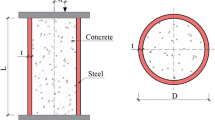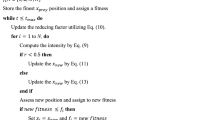Abstract
The purpose of this study is to use multivariate adaptive regression spline (MARS) and extreme learning machine (ELM) artificial intelligence models to estimate the compressive strength of the circular concrete columns wrapped with FRP sheets. In addition, to improve the accuracy of these models, the particle swarm optimization (PSO) algorithm was used in combination with these models, and the accuracy of the models was evaluated to estimate the strength values. The results indicate that in general, the artificial intelligence models estimate the compressive strength of FRP-wrapped columns more accurately than the existing analytical models. In particular, the combined MARS–PSO model offered a better performance compared to the other models, as this model has correlation coefficients of 0.9972 and 0.9961 in the training and testing phases, respectively. Moreover, a combination of the PSO algorithm with the two models, MARS and ELM, improved their accuracy by 6.13 and 4.68%, respectively.














Similar content being viewed by others
Data availability
Enquiries about data availability should be directed to the authors.
References
Ahmad S, Khaloot A, Irshaid A (1991) Behaviour of concrete spirally confined by fibreglass filaments. Mag Concr Res 43:143–148
Ahmadi M, Naderpour H, Kheyroddin A (2014) Utilization of artificial neural networks to prediction of the capacity of CCFT short columns subject to short term axial load. Arch Civ Mech Eng 14:510–517
Ahmadi M, Naderpour H, Kheyroddin A (2017) ANN model for predicting the compressive strength of circular steel-confined concrete. Int J Civ Eng 15:213–221
Akbari M, Deligani VJ (2020) Data-driven models for compressive strength prediction of concrete at high temperatures. Front Struct Civ Eng 14(2):311–321
Akbari M, Henteh M (2019) Comparison of Genetic Algorithm (GA) and Particle Swarm Optimization Algorithm (PSO) for discrete and continuous size optimization of 2D truss structures. J Soft Comput Civ Eng 3(2):76–97
Altun F, Kişi Ö, Aydin K (2008) Predicting the compressive strength of steel fiber added lightweight concrete using neural network. Comput Mater Sci 42(2):259–265
Ashrafian A, Taheri Amiri M, Haghighi F (2019) Modeling the slump flow of self-compacting concrete incorporating metakaolin using soft computing techniques. J Struct Constr Eng 6(2):5–20
Asteris PG, Ashrafian A, Rezaie-Balf M (2019) Prediction of the compressive strength of self-compacting concrete using surrogate models. Comput Concr 24(2):137–150
Cascardi A, Micelli F, Aiello MA (2017) An Artificial Neural Networks model for the prediction of the compressive strength of FRP-confined concrete circular columns. Eng Struct 140:199–208
Chai T, Draxler RR (2014) Root mean square error (RMSE) or mean absolute error (MAE). Geosci Model Dev Discuss 7(1):1525–1534
Clerc M (2010) Particle swarm optimization. Wiley, New Jersey
Deng W, Yao R, Zhao H, Yang X, Li G (2019) A novel intelligent diagnosis method using optimal LS-SVM with improved PSO algorithm. Soft Comput 23(7):2445–2462
DeRousseau MA, Laftchiev E, Kasprzyk JR, Rajagopalan B, Srubar WV III (2019) A comparison of machine learning methods for predicting the compressive strength of field-placed concrete. Constr Build Mater 28:116661
Eshghali M, Kannan D, Salmanzadeh-Meydani N, Esmaieeli Sikaroudi AM (2023) Machine learning based integrated scheduling and rescheduling for elective and emergency patients in the operating theatre. J Ann Oper Res 1–24
Fam AZ, Rizkalla SH (2000) Concrete-filled FRP tubes for flexural and axial compression members. In: Proceedings of the third international conference on advanced composite materials in bridges and structures, Ottawa, ON, Canada
Fam A, Rizkalla SH (2001) Behavior of axially loaded concrete-filled circular FRP tubes. ACI Struct J 98(3):280–289
Fardis MN, Khalili H (1981) Concrete encased in fiberglass-reinforced-plastic. J Am Concr Inst 78(6):440–446
Feng DC, Liu ZT, Wang XD, Chen Y, Chang JQ, Wei DF, Jiang ZM (2020) Machine learning-based compressive strength prediction for concrete: an adaptive boosting approach. Constr Build Mater 230:117000
Friedman JH (1991) Multivariate adaptive regression splines. Ann Stat 19:1–141
Golafshani EM, Behnood A, Arashpour M (2020) Predicting the compressive strength of normal and High-Performance Concretes using ANN and ANFIS hybridized with Grey Wolf Optimizer. Constr Build Mater 232:117266
Haji M, Naderpour H, Kheyroddin A (2019) Experimental study on influence of proposed FRP strengthening techniques on RC circular short columns considering different types of damage index. Compos Struct 209:112–128
Hanteh R, Hanteh M, Kheyroddin A, Rezaifar O (2020) Determination of strength parameters in roller compacted concrete (RCC) dams using laboratory results and forecasting based on artificial neural networks. Modares Civ Eng J 20(2):55–70
Harmon TG, Slattery KT (1992) Advanced composite confinement of concrete. In: Proceedings of the First International Conference on Advanced Composite Materials in Bridges and Structures, Sherbrooke, QC, Canada
Huang GB, Zhou H, Ding X, Zhang R (2011) Extreme learning machine for regression and multiclass classification. IEEE Trans Syst Man Cybern Part B (cybern) 42(2):513–529
Ilyas I, Zafar A, Talal Afzal M, Faisal Javed M, Alrowais R, Althoey F, Mustafa Mohamed A, Mohamed A, Ivanovich Vatin N (2022) Advanced machine learning modeling approach for prediction of compressive strength of FRP confined concrete using multiphysics genetic expression programming. Polymers 14(9):1789
Jamali F, Mousavi SR, Bahr Peyma A, Moodi Y (2022) Prediction of compressive strength of fiber-reinforced polymers-confined cylindrical concrete using artificial intelligence methods. J Reinf Plast Compos 41(1):7–18
Jekabsons G (2010) VariReg: a software tool for regression modelling using various modeling methods. RigaTechnical University, Riga
Keshavarz Z, Torkian H (2018) Application of ANN and ANFIS models in determining compressive strength of concrete. Soft Comput Civ Eng 2:62–70
Keshtegar B, Sadeghian P, Gholampour A, Ozbakkaloglu T (2017) Nonlinear modeling of ultimate strength and strain of FRP-confined concrete using chaos control method. Compos Struct 163:423–431
Keshtgar B, Gholampour A, Thai D-K, Taylan O, Trung NT (2021) Hybrid regression and machine learning model for predicting the ultimate condition of FRP-confined concrete. Compos Struct 262:113644
Kono S, Inazumi M, Kaku T (1998) Evaluation of confining effects of CFRP sheets on reinforced concrete members. In: Proceedings of the second international conference on composites in infrastructure national science foundation, Tucson, AZ, USA
La Tegola A, Manni O (1999) Experimental investigation on concrete confined by fiber reinforced polymer and comparison with theoretical model. Spec Publ 188:243–254
Lazinica A (2009) Particle swarm optimization. Intech, Rijeka
Mahmoudabadi M, Sakhaeipour F (2020) Numerical analysis on the influence of the cross section of ultimate capacity of reinforced concrete columns reinforced with CFRP. J Struct Constr Eng 7(1):107–125
Matthys S, Taerwe L, Audenaert K (1999) Tests on axially loaded concrete columns confined by fiber reinforced polymer sheet wrapping. Spec Publ 188:217–228
Micelli F, Myers J, Murthy S (2001) Effect of environmental cycles on concrete cylinders confined with FRP. In: Proceedings of the CCC2001 International Conference on Composites in Construction., Porto, Portugal
Mirmiran A, Shahawy M (1997) Behavior of concrete columns confined by fiber composites. J Struct Eng 123:583–590
Miyauchi K (1997) Estimation of strengthening effects with carbon fiber sheet for concrete column. In: Proceedings of the 3rd international symposium on non-metallic (frp) reinforcement for concrete structures., Sapporo, Japan
Moodi Y, Mousavi SR, Sohrabi MR (2019) New models for estimating compressive strength of concrete confined with FRP sheets in circular sections. J Reinf Plast Compos 38(21):1014–1028
Naderpour H, Alavi SA (2017) A proposed model to estimate shear contribution of FRP in strengthened RC beams in terms of adaptive neuro-fuzzy inference system. Compos Struct 170:215–227
Naderpour H, Mirrashid M (2018) An innovative approach for compressive strength estimation of mortars having calcium inosilicate minerals. J Build Eng 19:205–215
Naderpour H, Kheyroddin A, Amiri GG (2010) Prediction of FRP-confined compressive strength of concrete using artificial neural networks. Compos Struct 92:2817–2829
Naderpour H, Rafiean AH, Fakharian P (2018) Compressive strength prediction of environmentally friendly concrete using artificial neural networks. J Build Eng 16:213–219
Nanni A, Bradford NM (1995) FRP jacketed concrete under uniaxial compression. Constr Build Mater 9:115–124
Pessiki S, Harries KA, Kestner JT, Sause R, Ricles JM (2001) Axial behavior of reinforced concrete columns confined with FRP jackets. J Compos Constr 5(4):237–245
Pham TM, Hadi MN (2014) Confinement model for FRP confined normal-and highstrength concrete circular columns. Constr Build Mater 69:83–90
Picher F, Rochette P, Labossiére P (1996) Confinement of concrete cylinders with CFRP. In: Proceedings of the international conference on composites in infrastructure, Tuscon, AZ, USA
Pour AF, Ozbakkaloglu T, Vincent T (2018) Simplified design-oriented axial stress-strain model for FRP-confined normal-and high-strength concrete. Eng Struct 175:501–516
Raza A, Khan QUZ, Ahmad A (2020) Prediction of axial compressive strength for FRPconfined concrete compression members. KSCE J Civ Eng 24(7):2099–2109
Realfonzo R, Napoli A (2011) Concrete confined by FRP systems: confinement efficiency and design strength models. Compos B Eng 42(4):736–755
Rochette P, Labossiere P (2000) Axial testing of rectangular column models confined with composites. J Compos Constr 4:129–136
Rousakis T, Tepfers R (2001) Experimental investigation of concrete cylinders confined by carbon FRP sheets, under monotonic and cyclic axial compressive load. Chalmers University of Technology, Goteborg
Saafi M, Toutanji H, Li Z (1999) Behavior of concrete columns confined with fiber reinforced polymer tubes. Mater J 96:500–509
Sadeghian P, Fam A (2015) Improved design-oriented confinement models for FRPwrapped concrete cylinders based on statistical analyses. Eng Struct 87:162–182
Sajedi F, Shafieinia M, Razavi Toosi V (2020) Investigation on the behavior of reinforced concrete columns made of high-strength concrete, enclosed with GRP casing and CFRP sheets. J Struct Constr Eng 7(4):202–219
Sevim UK, Bilgic HH, Cansiz OF, Ozturk M, Atis CD (2021) Compressive strength prediction models for cementitious composites with fly ash using machine learning techniques. Constr Build Mater 27:121584
Shahawy M, Mirmiran A, Beitelman T (2000) “Tests and modeling of carbon-wrapped concrete columns. Compos Part B Eng 31:471–480
Shariati KB, Mafipour M, Mehrabi MS, Bahadori P, Zandi A, Salih Y et al (2019) Application of a hybrid artificial neural network-particle swarm optimization (ANN-PSO) model in behavior prediction of channel shear connectors embedded in normal and high-strength concrete. Appl Sci 9(24):5534
Sun L, Koopialipoor M, Jahed Armaghani D, Tarinejad R, Tahir MM (2019) Applying a meta-heuristic algorithm to predict and optimize compressive strength of concrete samples.Eng Comput 1–13
Taheri Amiri MJ, Ashrafian A, Haghighi FR, Javaheri Barforooshi M (2019) Prediction of the compressive strength of self-compacting concrete containing rice husk ash using data driven models. IQBQ 19(1):209–221
Topcu IB, Sarıdemir M (2008a) Prediction of compressive strength of concrete containing fly ash using artificial neural networks and fuzzy logic. Comput Mater Sci 41(3):305–311
Topcu IB, Sarıdemir M (2008b) Prediction of rubberized concrete properties using artificial neural network and fuzzy logic. Constr Build Mater 22(4):532–540
Toutanji H (1999) Stress–strain characteristics of concrete columns externally confined with advanced fiber composite sheets. Mater J 96:397–404
Vintzileou E, Panagiotidou E (2008) An empirical model for predicting the mechanical properties of FRP-confined concrete. Constr Build Mater 22:841–854
Watanabe K, Nakamura H, Honda Y, Toyoshima M (1997) Confinement effect of FRP sheet on strength and ductility of concrete cylinders under uniaxial compression. In: Proceedings of the third international symposium (FRPRCS-3) on non-metallic (FRP) reinforcement for concrete structures, Sapporo, Japan, pp 233–240
Zhou C, Gao HB, Gao L, Zhang WG (2003) Particle swarm optimization (PSO) algorithm. Appl Res Comput 12:7–11
Zhu SL, Heddam S, Nyarko EK, Hadzima-Nyarko M, Piccolroaz S, Wu SQ (2019) Modeling daily water temperature for rivers: comparison between adaptive neuro-fuzzy inference systems and artificial neural networks models. Environ Sci Pollut Res 26:402–420
Funding
The authors have not disclosed any funding.
Author information
Authors and Affiliations
Corresponding author
Ethics declarations
Competing interest
The authors have not disclosed any competing interests.
Additional information
Publisher's Note
Springer Nature remains neutral with regard to jurisdictional claims in published maps and institutional affiliations.
Rights and permissions
Springer Nature or its licensor (e.g. a society or other partner) holds exclusive rights to this article under a publishing agreement with the author(s) or other rightsholder(s); author self-archiving of the accepted manuscript version of this article is solely governed by the terms of such publishing agreement and applicable law.
About this article
Cite this article
Hanteh, M., Malek, H. & Kheyroddin, A. Proposing the combined MARS–PSO and ELM–PSO models for estimating the compressive strength of circular concrete columns wrapped with FRP sheets. Soft Comput 27, 15937–15953 (2023). https://doi.org/10.1007/s00500-023-08854-x
Accepted:
Published:
Issue Date:
DOI: https://doi.org/10.1007/s00500-023-08854-x




